
VSCO girls: authentics, wannabes and ridiculers
VSCO girls are a micro-population, primarily found on Instagram, TikTok and YouTube, which started to gain traction at the end of May 2019. Mostly consisting of teenage girls, the group is recognizable by its beachy aesthetic, striking clothing trends and jargon. But the brand-specificness of its identity emblems raises questions as to who counts as an authentic VSCO girl, creating a subgroup of wannabes. Apart from their idealistic reputation, VSCO girls are also known for the parodies made about them. In this article, I will try to bring light to the culture of VSCO girls, the stratification that emerges within it, and the co-construction of the culture by its ridiculers.
What are VSCO girls?
The VSCO girl community can be regarded as a micro-population, formed on the basis of a shared aesthetic, identity and discourse on social media. It is mainly located and spread on the internet, and it is translocal, polycentric and stratified, as will be discussed later in this article. Apart from it being a micro-population “constructed through networked technologies” like social media, it is an imagined community, in the sense that “the members will never know most of their fellow-members, meet them or even hear of them, yet in the minds of each lives the image of their communion” (boyd, 2015; Anderson, 1983).
Teenage girls who started putting on the bright VSCO filters created a VSCO girl identity.
The name "VSCO girl" (pronounced “visco girl”) comes from Visual Supply Company (or VSCO for short). VSCO is an app and online platform which enables users to upload, edit and post photos. The app is known for its bright preset filters and editing options. In April 2018, VSCO had over 30 million users, 75% of which were Generation Z (that is, people born between 1995 and 2015, so currently between 4 and 24 years old).
Teenage girls who started putting on the bright VSCO filters created a VSCO girl identity. After visiting many Instagram accounts connected to VSCO girls, it became clear to me that VSCO girls almost always self-identify as such. From sending the accounts some direct messages with questions, I found out that most girls do use the VSCO app, even though they most actively post pictures on Instagram. They enjoy “the accessories, clothes and [of course] the good vibes” and “filtering [their] images and gaining inspiration from other VSCO girls.”
Figure 1. A VSCO girl starter pack
Figure 1 shows a so-called “VSCO girl starter pack”, found on a VSCO girl inspiration account. It clearly shows the commodities needed to sport the VSCO girl identity. Many of these starter packs for VSCO girls can be found on the internet, all showing nearly identical items. VSCO girls are easily recognizable by their many identity markers shown in these starter packs: wide t-shirts, "scrunchies" (elastic bands covered in fabric, often used as hair accessories or bracelets, see Figure 1 for an example), bracelets, Vans, Crocs or Birkenstocks, Hydro Flasks, Fjallraven Kanken backpacks, Mario Badescu facial spray, metal straws, and shell necklaces, just to name a few.

Figure 2. Someone promoting commodities to the VSCO girls
Figure 2 shows a comment found under a VSCO girl post, which promotes a small shop selling scrunchies in North America. Clearly, the owner expected to reach North American customers interested in scrunchies with this comment. It is undersood that such an audience can easily be found in the comment section of a VSCO girl inspiration account.
The right combination
By definition, the VSCO-identity goes together with commodities since it is near impossible to be an authentic VSCO girl without the right materialistic markers. “Identity is a matter of ‘enoughness’: one has to have, display and enact ‘enough’ of the emblematic features in order to be ratified as an authentic member of an identity category” (Maly & Varis, 2016). For VSCO these emblematic features or identity markers are very brand-specific and should not be over-exaggerated. This means that - apart from enoughness - there should also be a sense of "enough is enough", which will be discussed later in this article.
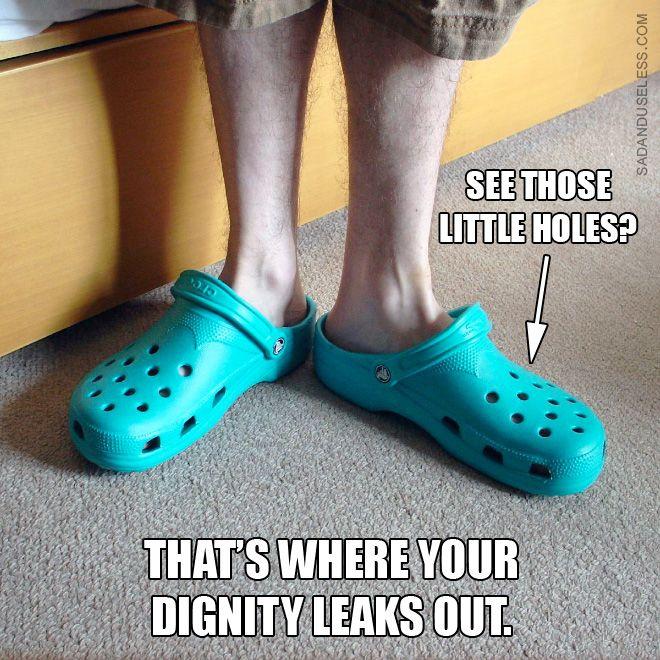
Figure 3. A meme about Crocs
The relevant commodities should be combined with much care in order to be considered VSCO girl emblems. Let's take the “Crocs” shoe brand as an example. As can be seen in Figure 3, wearing Crocs can be strongly frowned upon (which can also be concluded from the existence of “what are those” videos).
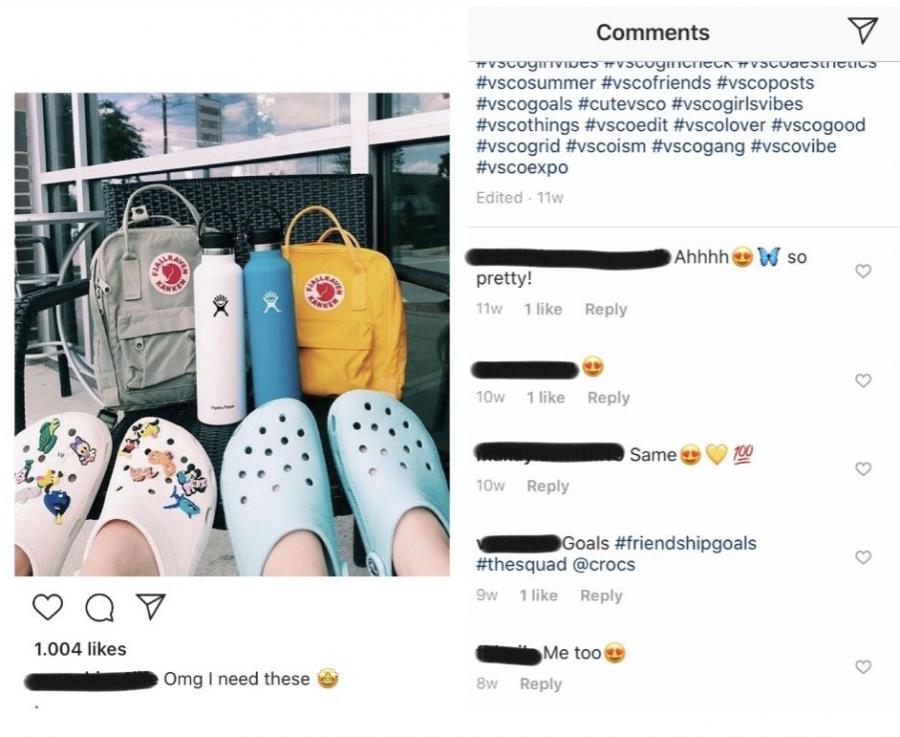
Figure 4. Crocs as a 'want'
In contrast, in Figure 4 - showing a post on a VSCO girl inspiration account and its comments - the shoes constitute a very desirable item. The person who posted the picture captioned it “omg I need these” and included many hashtags containing the word VSCO. Others responded with “same”, “ahhhh so pretty” and “goals #friendshipgoals #thesquad @crocs”. The picture shows not only Crocs but also Hydro Flasks and Fjallraven Kanken backpacks, both known as identity markers of the VSCO girls too (see Figure 1). The post in Figure 4 places Crocs within an environment of VSCO culture, where they become a notable fashion statement instead of a shoe to avoid. So, only if the shoes are combined with other identity markers can they be placed in a VSCO girl environment and thereby become a desirable item for VSCO girls. Someone who wears Crocs can be seen as an outcast (see Figure 3), but someone who wears them correctly - that is, combined with other specific items - becomes a VSCO girl.
VSCO talk
The jargon used by the VSCO girls - “sksksks”, “and I oop-” and “save the turtles” - is very recognizable. “Sksksksk” can be used to denote laughing, or as a kind of "filler" reaction that does not really imply something. When typing on a mobile phone, the thumbs will most easily touch the S and K, making it a fast and easy response.
“And I oop-” comes from a video by drag queen Jasmine Masters, who later explained that she originally exclaimed the phrase because she sat on her testicles while speaking. It is used as an expression of shock. “Save the turtles” is mostly used when talking about metal straws. VSCO girls often care a lot about the environment - hence their reusable thermos flasks and metal straws - and share this opinion with others by encouraging them to save the turtles by not using single-use plastics the turtles can choke on.
Wannabes
As mentioned earlier, the VSCO girl identity is linked to specific commodities by definition. One has to have the right outfit, accessories and even skincare. It is very brand-specific: any thermos flask will not suffice, it has to be a certain model of the brand Hydro Flask, preferably in a bright color and decorated with large pastel-colored stickers or paint. This is clearly illustrated in Figures 5 and 6.
Figure 5. A collection of YouTube thumbnails
Figure 5 shows a collection of thumbnails from YouTube videos about girls trying to become VSCO girls. They are all holding Hydro Flask thermos flasks in bright colors and decorated with stickers. These four pictures provide just a few examples, as an image search for “VSCO girl” will result in endless pictures with Hydro Flasks.
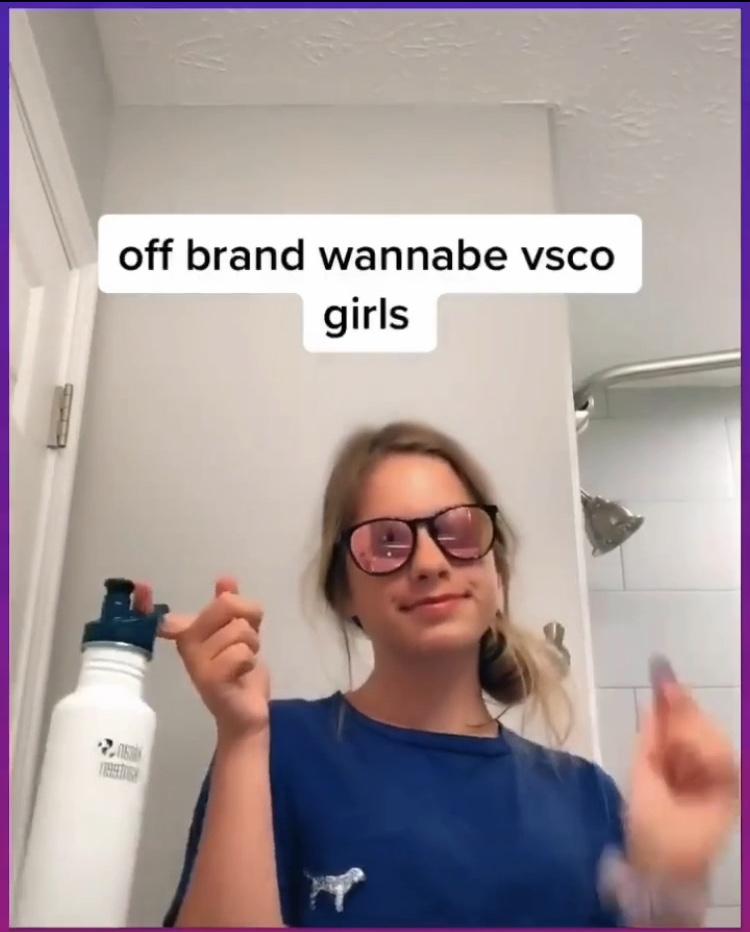
Figure 6. A screenshot from a TikTok
Figure 6 shows a screenshot from a TikTok video. It is captioned “off brand wannabe vsco girls” and the girl in it is holding a thermos flask from a brand other than Hydro Flask. This shows that one needs to be particular in their choice of thermos flask if they want to be a VSCO girl, because if you own the wrong brand you will be considered a wannabe.
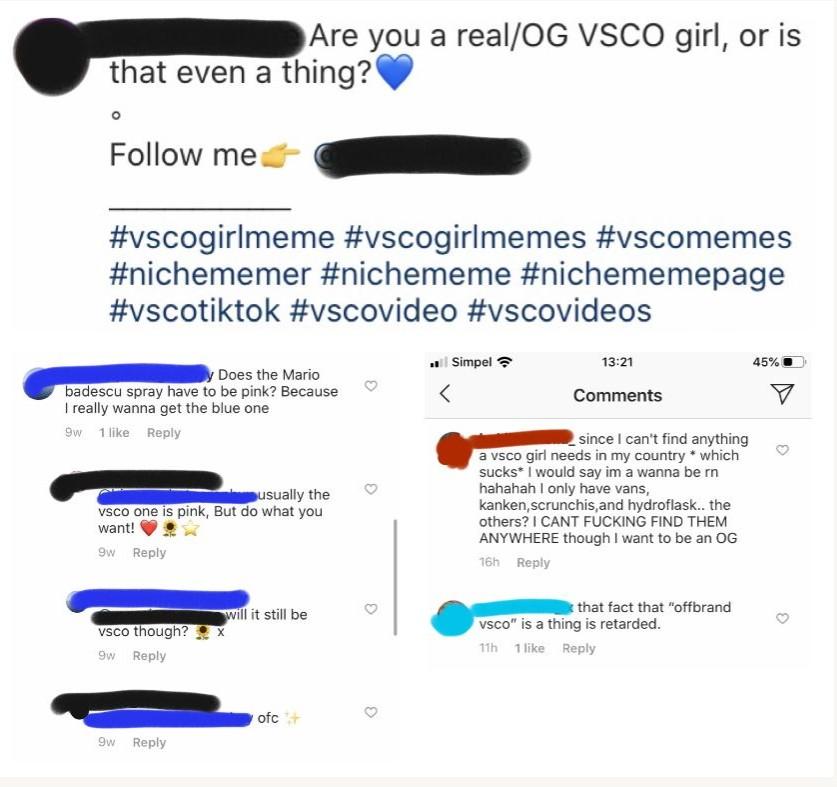
Figure 7. Comments about 'wannabe' VSCO girls
The video from Figure 6 was reposted on a VSCO inspiration account on Instagram with the caption “Are you a real/OG VSCO girl, or is that even a thing?” The post started a discussion about authenticity and wannabes. One person commented “that fact that “offbrand vsco” is a thing is retarded,” while a different person seemed to be more worried and commented: “since I can’t find anything a vsco girl needs in my country *which sucks* I would say im a wanna be rn hahahah I only have vans, kanken, scrunchis, and hydroflask… the others? I CANT FUCKING FIND THEM ANYWHERE though I want to be an OG”. Multiple girls commented under this post about their struggles to find the right items in the countries they live in.
As the center of the identity lies in the United States, where the VSCO girls are most popular, all identity markers can be found in stores in the US. However, for girls living in other countries, it is a challenge to find some of the brands. For example, Hydro Flask does not ship internationally, so it will be a bigger challenge, if even possible, for "international" VSCO girls to be "authentic" and own the correct brands. Apart from availability, the cost can also be a problem. The VSCO girl identity has been estimated to cost $229,89, but the costs can rise a lot more with every addition, most notably with a pair of AirPods, which costs around $159. The brands "necessary" for someone to be an "OG VSCO girl" are not available everywhere and to everyone, creating a divide between the (wealthy) North American and international VSCO girls. In theoretical terms, this makes the micro-population translocal, polycentric and stratified (Maly and Varis, 2016).
Insecurities and uncertainties
This discussion on authenticity can lead to many insecurities and uncertainties for a teenage girl. Since there are no written rules about when one is an authentic VSCO girl, many girls turn to the inspiration accounts to ask for help. One example is the thread of comments in Figure 7. “Does the Mario Badescu spray [a facial spray from skin care brand Mario Badescu] have to be pink? Because I really wanna get the blue one.” The answer is as follows: “usually the vsco one is pink, But do what you want!” This answer does not seem to solve the insecurity. The girls facing these questions could do what they want, but they do not want to be seen as a "fake": “will it still be vsco though? x” Luckily, the answer in this case is: “ofc. [of course]” Apparently the label of "wannabe" or "fake" is so feared that the girl posing the question wanted to make sure that a blue facial spray would not result in being labeled as such before buying it.
"VSCO girl" is used as an umbrella term that includes the subgroups of "authentics" and "wannabes".
Considering that the label is so feared by some, a "wannabe" can be seen as a deviant one, an outsider within the group. Every group has rules decided by consensus, which are enforced by everyone (involved). The notion of deviance depends on many factors, such as time, the person who "breaks the rules", the "victim" and the consequences (Becker, 1997). As discussed above, I found that there is no real consensus on whether having the "wrong" brands, or being a "wannabe", is an act of deviance, or whether it should be accepted. On the one hand, there are comments like “that fact that “offbrand vsco” is a thing is retarded” and on the other, there are also the girls commenting about their insecurities concerning not being considered a "real" VSCO girl. This is why - in this article - "VSCO girl" is used as an umbrella term that includes the subgroups of "authentics" and "wannabes". This single term allows objective communication about the phenomenon without stating an opinion on the distinction between the two.
Ridiculers
Notably, all interviewed girls admitted that their VSCO identity was mostly an online identity, and that they would not consider themselves VSCO girls in their offline lives. One account mentioned that people at her school did not even know that she had this account, only close friends and family did. These anonymous accounts mean that the girls deliberately keep their online and offline identities separated, out of fear of being ridiculed. It allows them to be a better version of themselves and enables them to reflect on their personalities and “type themselves into being”, leaving their “material - or physically embodied - identities” behind (boyd, 2015).
The teenage girls leave their accounts "open" - granting everybody access to their posts - to encourage peers with the same interests to interact with them, not realizing that this can result in unintended guests who do not share these interests or have different media ideologies. People have different views on how media should be used and will act accordingly. Where VSCO girls see Instagram as a platform focusing on aesthetics and inspiration, others see it as sole entertainment and not as something serious (Varis, 2014). It is important to consider that an imagined audience is often not representative of one's actual audience. This sometimes sometimes results in the micro-population being ridiculed by outsiders (boyd, 2015).
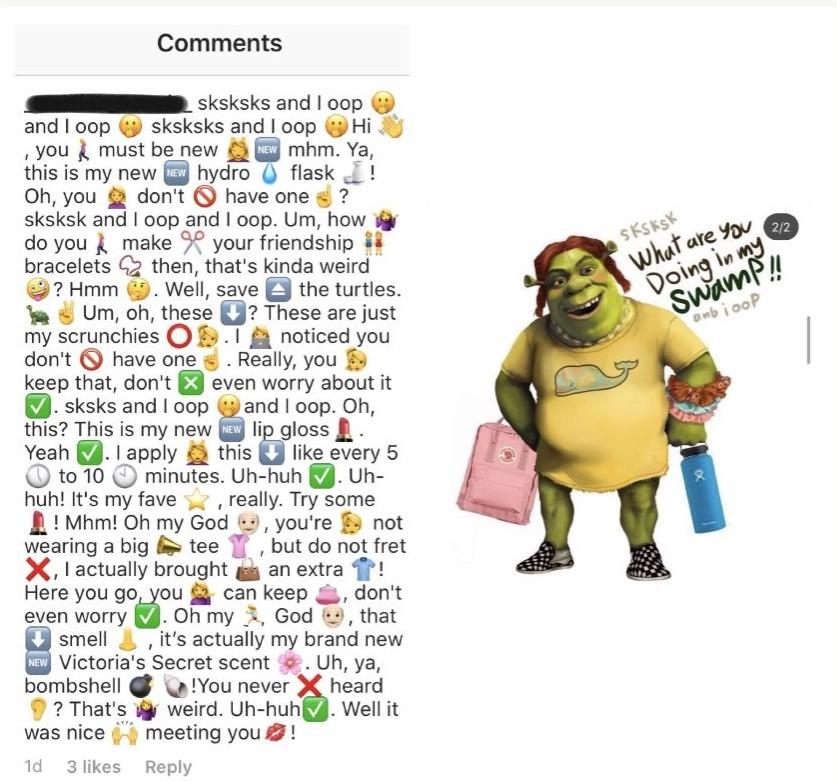
Figure 8. A comment and a picture of Shrek as a VSCO girl
This is how VSCO girl parodies began. People who did not identify with the VSCO girl ideology started publicly ridiculing it after coming across it by over-exaggerating its identity markers and jargon. More and more satire posts started to appear, gaining as much, if not more, attention as the sincere VSCO girl posts did. Figure 8 shows two examples of this kind of ridiculing. On the left is a comment under a VSCO girl post which shows an Instagram user overusing the jargon by using "sksksksks" and "I oop" after almost every sentence. Also, they sum up many identity markers, something that also regularly happens in videos like the one below. Above, on the right is a picture of the movie character Shrek who is turned into a VSCO girl. This post is emblematic for the trend of turning any- and everything into a "VSCO girl".
The ridiculers purposely reject the idea of "enough is enough": for them, the more identity markers, the better and funnier. Many videos like the one above have appeared, where people display their view of VSCO girls, often over-exaggerating the jargon and identity markers a lot. For example, people can be seen wearing over ten scrunchies on one arm, like Shrek is in Figure 8. When asked if the satire bothered her, a girl behind one of the accounts I interviewed, who wishes to stay anonymous, responded by saying “Yeah a little bit, there are people who take VSCO girl stereotypes too far, it has kind of ruined the whole VSCO stereotype if I’m being honest, I wish people wouldn’t troll it.”
Constructing VSCO girls from the outside
The ridiculers completely changed the VSCO girl culture and the way people view them. One’s self-representation is not only constructed by one's own behavior, but also by other people’s responses to it (boyd, 2015).
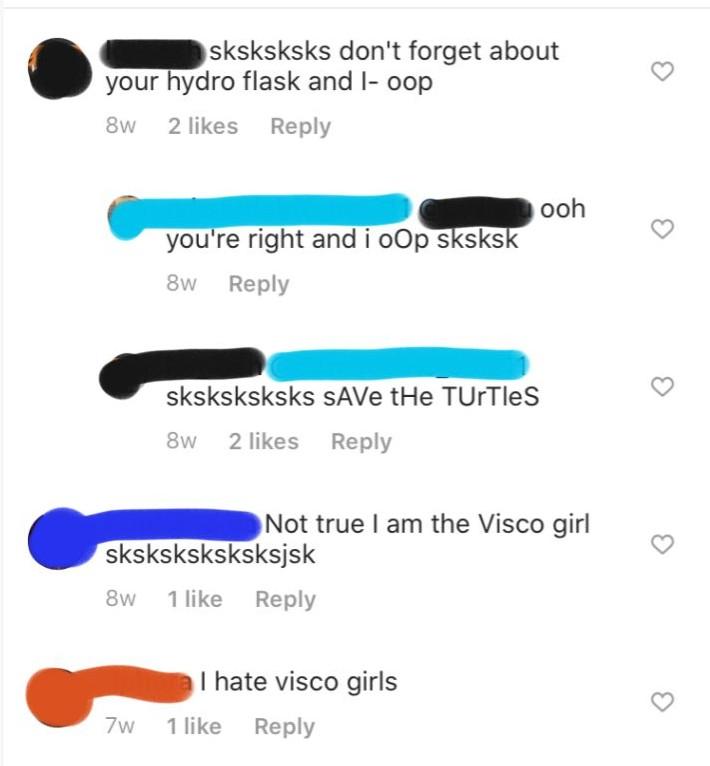
Figure 9. Mockery in the comments
As can be seen in Figure 9, a comment section beneath a picture posted by a VSCO girl account, a post can be put in a totally different context when outsiders come across it. The phrases that occur above are not an unusual sight in a VSCO girl comment section, but the alternating normal and capital letters used here often insinuate a form of mocking (by alluding to the mocking Spongebob meme). Also, the comment “not true I am the visco girl sksksk(...)” could signal an outsider as the word "VSCO" was misspelled. A person who is unfamiliar with VSCO girls might not be aware that this is akind of mockery and can get to know the VSCO girls as this over-exaggerated phenomenon. “Impression management online and off is not just an individual act; it’s a social process.” (boyd, 2015).
To outsiders, VSCO girls might seem like one homogeneous population, but the opposite is true (Maly & Varis, 2016). Apart from the subjective distinction between the "authentics" and the "wannabes" - who are referred to under the umbrella term "VSCO girls" in this article - there is a distinction between the VSCO girls and their ridiculers. Ridiculers appropriate VSCO girls' identity markers to shape their image from the outside, functioning as labeling-agents.
References
Anderson, B. R. O. G. (1983). Imagined communities: reflections on the origin and spread of nationalism. New York: Verso.
Becker, H. S. (1997). Outsiders. London: Free Press
boyd, d. (2015). It’s complicated: the social lives of networked teens. New Haven: Yale University Press
Maly, I., & Varis, P. (2016). The 21st-century hipster: On micro-populations in times of superdiversity. European Journal of Cultural Studies, 19(6), 637–653. doi: 10.1177/1367549415597920
Varis, P. (2014). Digital ethnography. Tilburg Papers in Culture Studies 104.